Give Your Houseplants a Little Lift |
At some point we all need support. And some of us need more than others. The same goes with houseplants. While some indoor plants have strong stems and readily grow without any staking or a trellis on which to cling, others need quite a bit of support to grow well and look their best.
Reasons to stake your houseplants
There are several reasons to support a plant. Staking helps unsteady plants and those with floppy flower heads stand up straight. Strategically placed supports can also train plants to grow in a particular direction.
How much support a plant requires depends on its growth habit. In their native environment, some plants naturally grow on trees and other woody plants.Staking can help such plants thrive.
Plants that require staking
Plants that benefit from some type of support fall into three categories. First, there are plants with flowers that look best when displayed upright, such as orchids. Insert a stake in the soil near the plant base and secure with green garden tape, which stretches as the plant grows.
The second category of plants that benefit from staking is the ramblers, trailers and climbers. Although many of these plants don’t necessarily need support, with a little direction and something to grow on, they can be trained to grow wherever you desire. These plants usually grow best on some sort of a trellis. Plants in this group include arrowhead vine, hoya, pothos, wandering Jew and ivy.
The third group of plants have aerial roots and grow best when allowed to fasten and climb onto a continuously moist, moss-covered pole. Two common plant types that fall into this category include the Swiss-cheese plant and various philodendrons.
Staking with moss-covered poles
You can find a moss-covered pole in the nursery, or make your own. To do so, create a narrow tube out of hardware cloth and fill with moistened sphagnum moss. (Always use gloves when handling wet sphagnum, as it harbors a fungus that can be harmful). You can also attach moss to a plastic pole with fine wire, such as 24-gauge copper wire or fishing line. Keep the moss moist by spraying on a regular basis.
Wide variety of stakes and trellises
Stakes and trellises come in a wide variety of styles, sizes, colors and materials. You’ll find everything from single stakes to heart-shaped trellises in bamboo, rattan, wood, metal, wire and plastic. Locate supports at nurseries and home supply stores, or make your own from disease-free twigs and branches from the garden.
Creating your own stakes and supports
To create your own supports, collect branches during deciduous prunings in January and February. New cuttings are moist and pliable and can be fashioned into just about any shape you want and tied. They will keep their new shape when they dry. Some good plant prunings to use include plum tree branches and wisteria and grape vines.
When selecting or creating a plant support, consider the size and style of your container. Metal supports are heaviest and can topple some pots. Bamboo and wood tend to be the most lightweight.
Installing stakes and supports
Although it’s best to install stakes and trellises before planting, that’s not always possible. Minimize root damage by inserting supports with care and placing them as deep as possible. Immediately wind the plant around the support and secure with green garden tape. Tie in two to three spots, so the plant isn’t vulnerable to breaking in any particular area.



